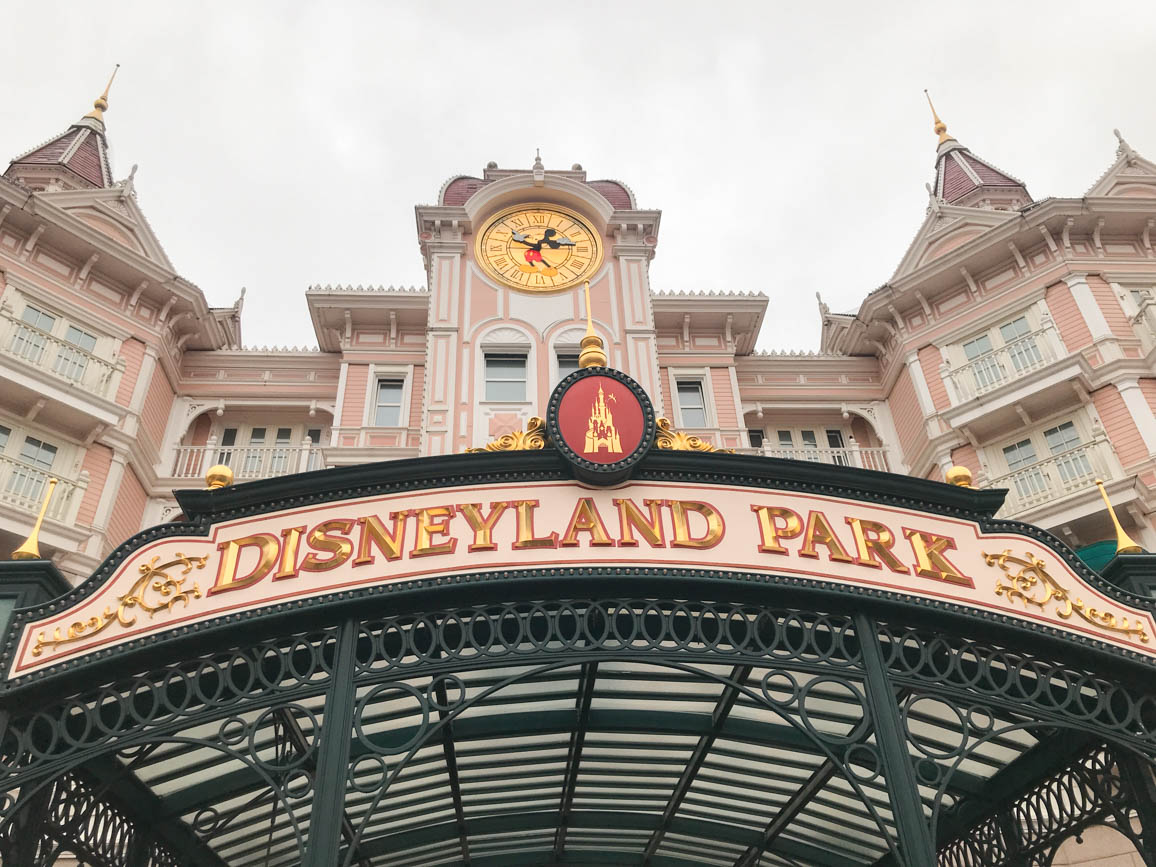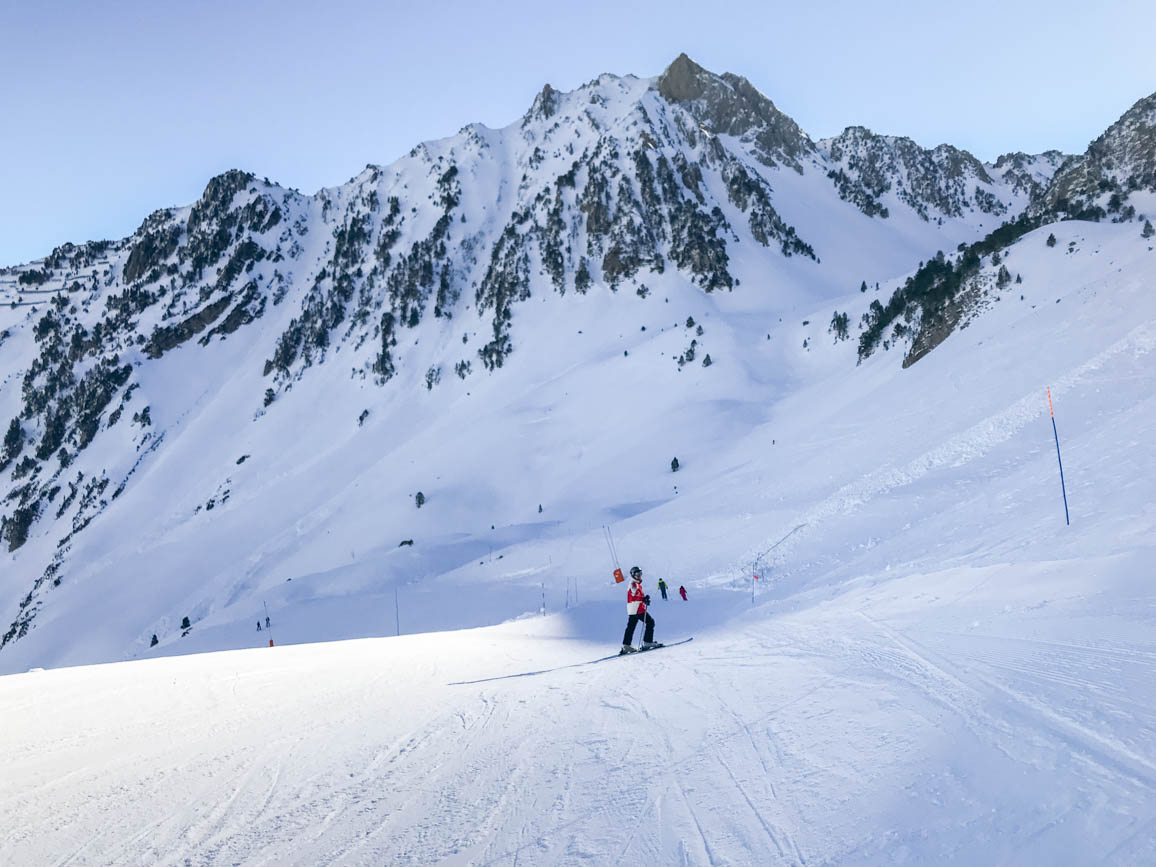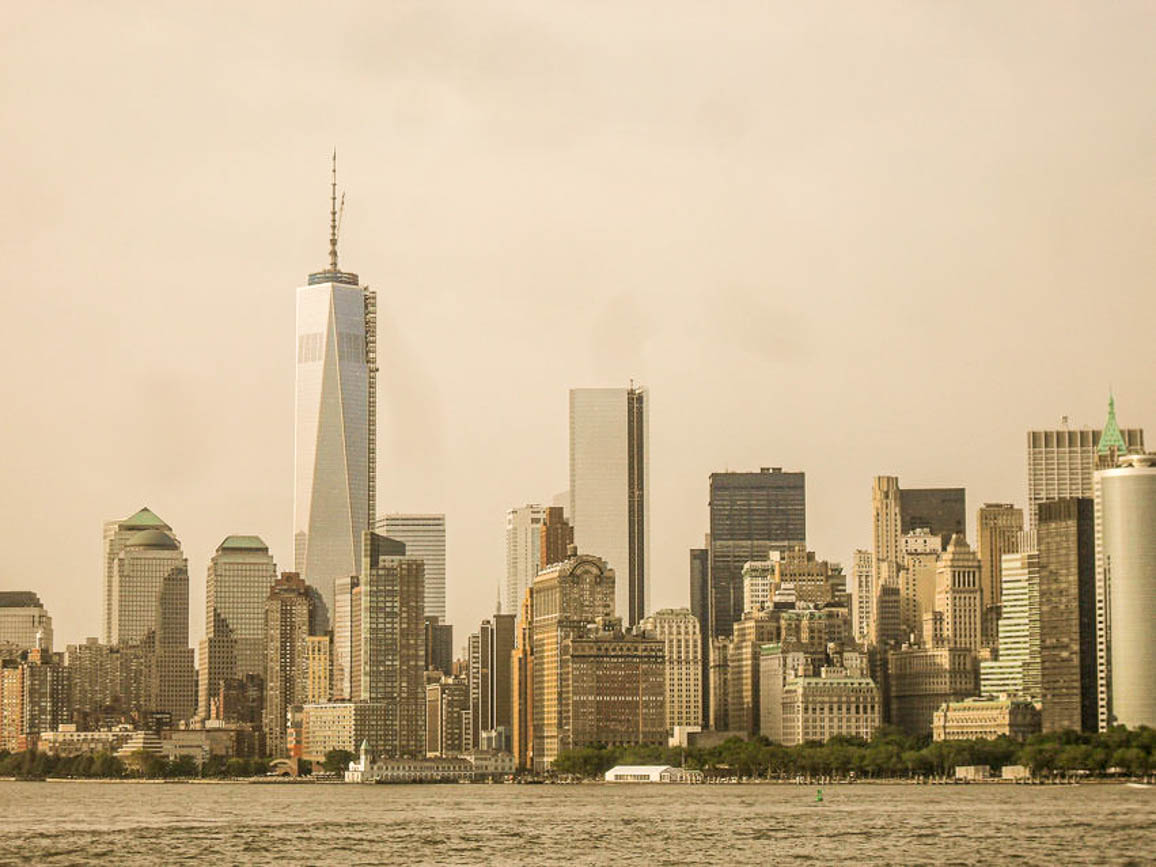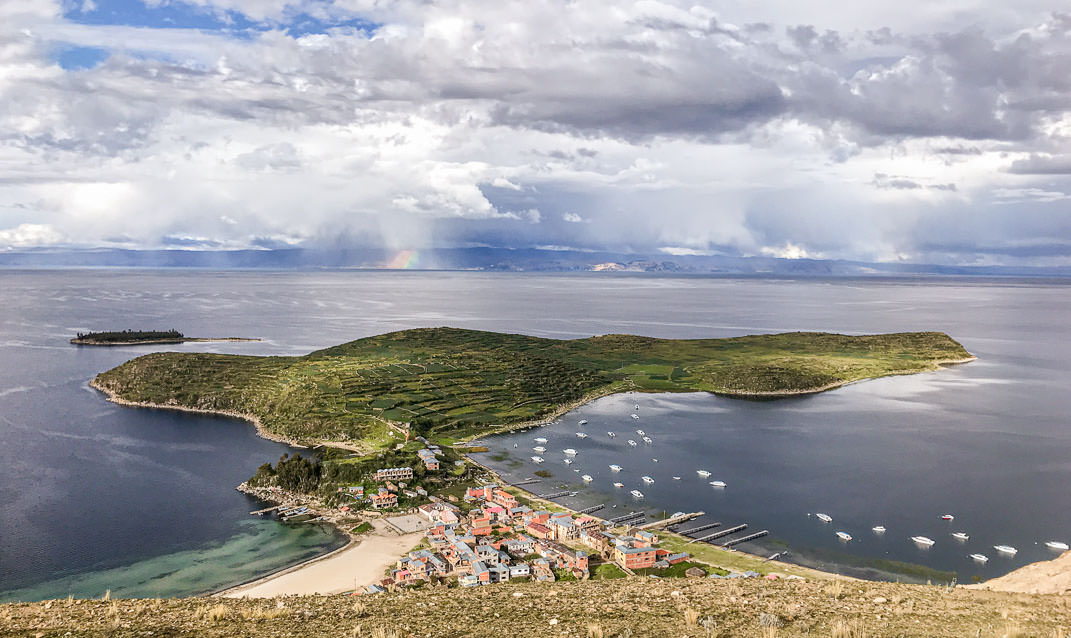
Lake Titicaca travel guide: Copacabana + Isla del Sol
Since this year there were no fun Carnival celebrations in Tarija because of the COVID pandemic, we decided to explore one of the must destinations in Bolivia: lake Titicaca. This mesmerizing lake located in the border with Peru has typically been a touristy spot for nationals and foreigners alike. Discover all there is to do in this travel guide, including tips for visiting Copacabana and the Island of the Sun (Isla del Sol).
At the end of this blog post you will find a map with all the spots mentioned in this article. Enjoy the reading and the pictures!
Lake Titicaca
Before traveling to the Titicaca lake, here are some basic facts you should know about this famous location:
- It is the largest freshwater lake in the world and it’s navigable. The lake measures 190km by 80km.
- It is also the highest lake on Earth, at an altitude of 3815 meters above sea level. This means you should take altitude sickness VERY seriously as you might experience difficulty when breathing because of the lack of oxygen. Hence, drink plenty of water or coca tea upon arrival and be careful with sports and any activity involving too much effort until your body feels more or less adjusted. If you want to be on the safe side, pack some Sorojchi pills and take one an hour before hitting your high altitude destination.
- Lake Titicaca is located in the border between Bolivia and Peru, meaning it is a shared resource by both countries. The Peruvian equivalent to Copacabana would be Puno. Since the borders were closed because of the COVID pandemic, we couldn’t cross into the Peruvian side but the usual ways to do so are in Kasani or Desaguadero.
- The lake was a sacred place for the Incas and played a a major role in Andean religious conceptions. The Incas believed their creator god Viracocha rose from its waters as well as their ancestors.
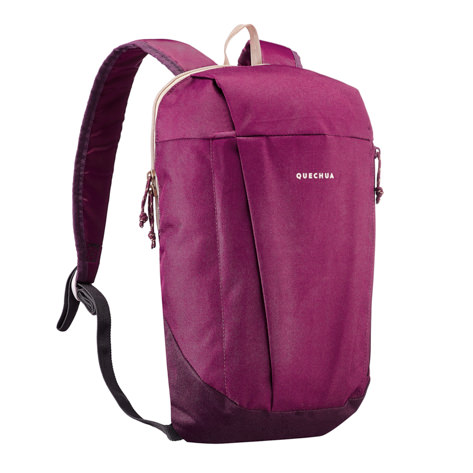
Small backpack
This 10 L backpack by Quechua is perfect to carry your essentials during your trekking outings.
It comes in various colors too.
Copacabana
Copacabana is the Bolivian lakeside town closest to Isla del Sol and is actually located on a peninsula, not to be mistaken with the Brazilian beach of the same name in Rio de Janeiro. 🙂
To get from La Paz to Copacabana, you will first need to cross from San Pablo de Tiquina into San Pedro de Tiquina on a rudimentary ferry transporting both people, cars or even buses.
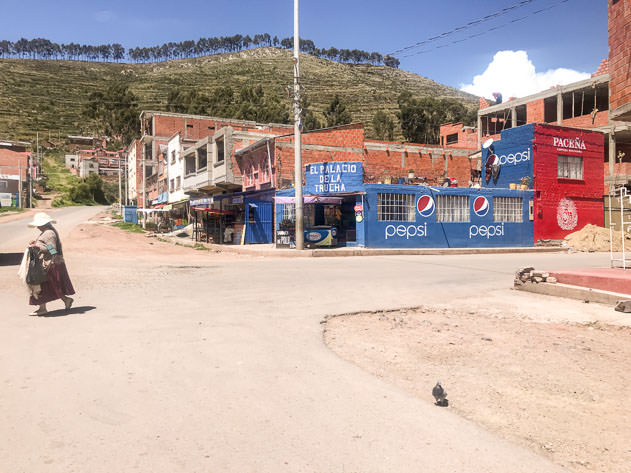
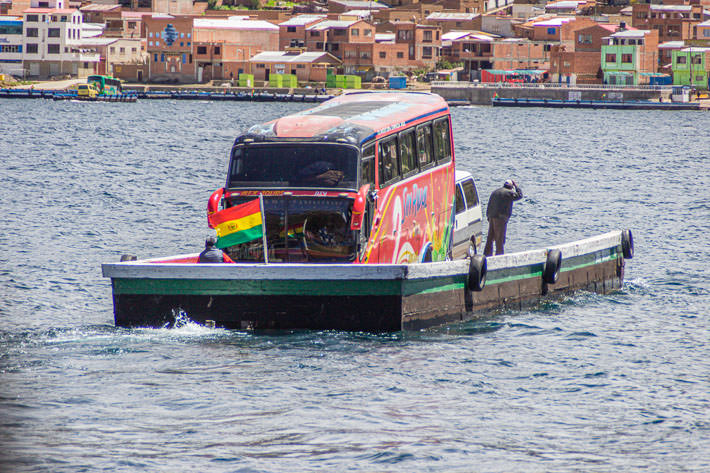
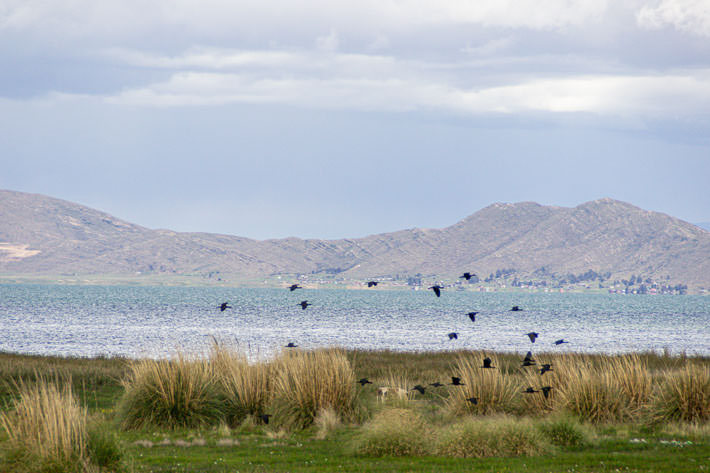
If you’re coming from La Paz, your first sight of the stunning lake Titicaca will be at Huarina or Huatajata, which are popular with ‘Paceños‘ for eating fresh trout and their views of the shoreline.
I bet you’ll be impressed by the deep blue color of the waters and by the vast extension of it all. It almost seemed like a real sea!
Note that there are actually two lakes: the smaller (lago Menor) and the bigger one (lago Mayor). When driving towards Copacabana, pay attention to the ‘sukakullos‘ (or ‘sukakollos‘), an ancient system of raised fields used by the inhabitants of nearby Tiwanaku to overcome the problems of drought, floods, frost and soil exhaustion. When traveling through the region, you will notice these carefully structured platforms all over. They typically stand over one meter high, with planting surfaces up to 200 meters long and 15 meters wide. Running in parallel lines, there are water-filled ditches between them.
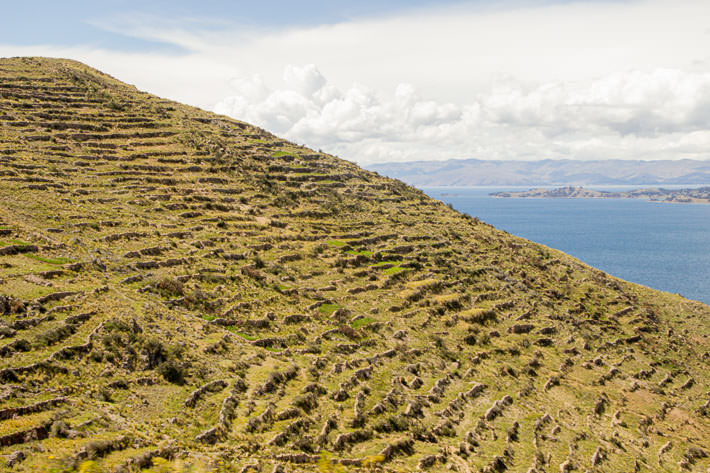
What to do in Copacabana

Copacabana is (or rather was before COVID-19) a very touristy spot for both Bolivians and foreigners alike since it’s the gateway to the fascinating islands on lake Titicaca.
Because of the pandemic, the city has lost plenty of tourists (mainly internationals) and its cafés and hostels looked empty. Such a sad situation!
Here’s my full list of the sightseeing activities you should do while in Copacabana:
- Check out Catedral de Copacabana. Bolivia’s most important Catholic shrine can be found here and its Cathedral is the main attraction in town. Built between the 16th and 17th centuries, its Moorish (mudéjar as we call it in Spain) style is imposing. Located in the central Plaza 2 de febrero, this impressive temple is worth the visit. Many pilgrims come here to revere the famous Virgen de Copacabana, also known as Virgen Morena. sculpted by a local called Francisco Inca Yupanqui in 1583. The religious statue is housed in a small chapel (camarín) to the left of the altar.
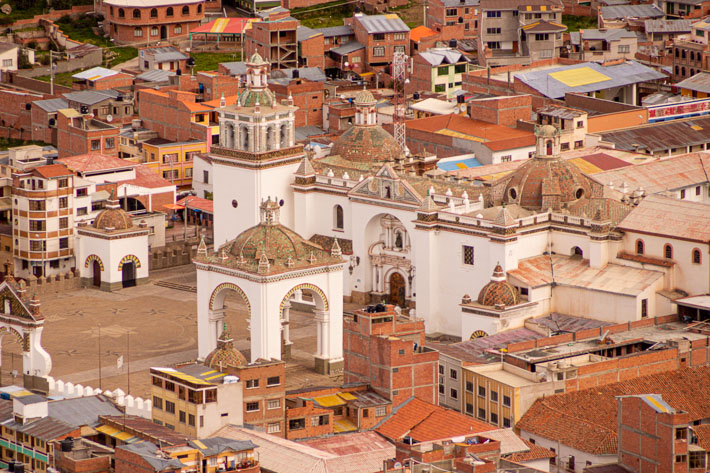
Aerial view of the Cathedral and the town of Copacabana in Bolivia.
- Experience the ‘bendiciones de movilidades‘ (or ch’alla): right in front of the Cathedral you might find priests blessing cars, buses and even trucks decorated with colorful flowers with holy water, beer or liquor. These happen generally around 10am every day and at 2pm on Sundays. This ‘ceremony’ is meant to ensure the safety of those vehicles in the future. If you’re looking for souvenirs, there are plenty of stands facing the Cathedral.
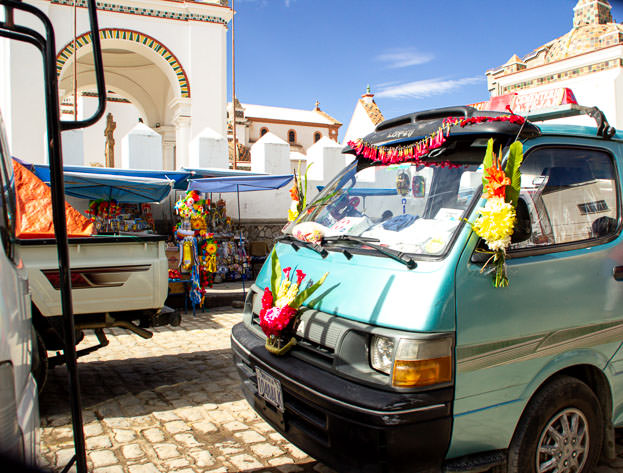
- Climb to Cerro Calvario for an impressive view of the lakeside town of Copacabana as well as of the surrounding lake Titicaca. Note that the way up the hill starting close to the chapel at the end of calle Destacamento 221 is very steep and should take you around 30 minutes, so be careful with the altitude sickness. During the climb you will pass through 14 stations of the cross before reaching a lookout (Mirador Sagrado Corazón de Jesús). Sadly, the path is full of litter and there are graffiti pretty much everywhere. You might also smell beer around you because there are smaller shrines where pilgrims light candles and pour alcoholic libations to ensure their prayers are heard.
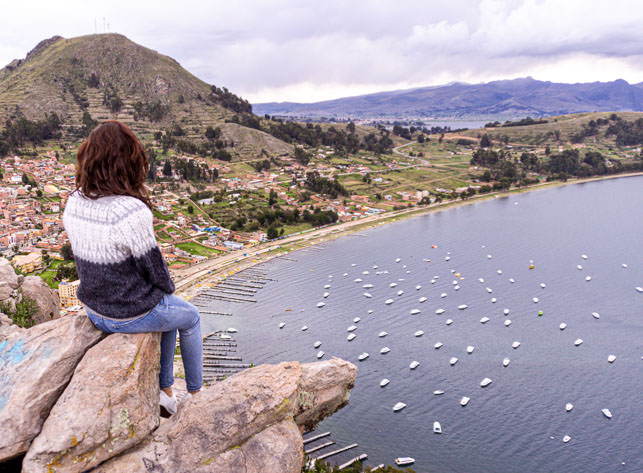
- Take a boat ride to Isla del Sol and Isla de la Luna: most boats to the islands on lake Titicaca depart from avenida Costanera in Copacabana. Alternatively, you can hike or take a taxi to Yampupata, located 17kms away. More on this below (3.1 How to get to Isla del Sol).
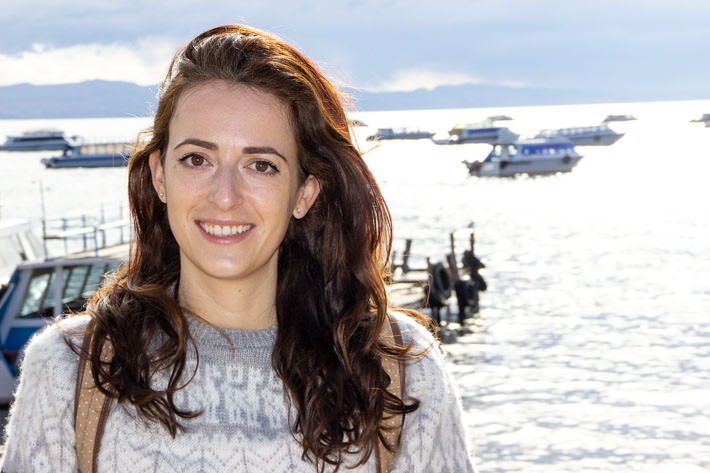
- Celebrate the Aymara New Year at the Horca del Inca and Intikala, two ancient shrines on the outskirts of town. The Aymaras are one of the largest indigenous groups in Bolivia, they speak their own language and live around lake Titicaca and the tropical Yungas. Their ‘epicenter’ is located in El Alto, next to La Paz.
Do you like my content? Subscribe to my newsletter to stay tuned.
In all honesty, apart from the Cathedral, the views from Cerro Calvario and the lake Titicaca itself, Copacabana is not especially attractive.
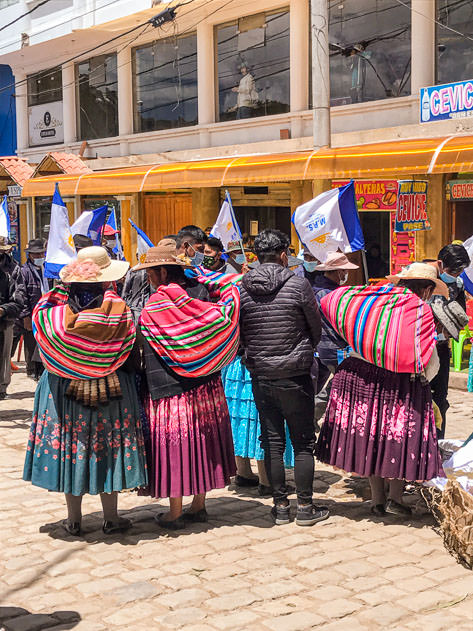
Where to stay in Copacabana
Although Copacabana is a very touristy place, many hotels and hostels tend to be on the cheaper side.
Here are some options you can look at when browsing for accommodation in Copacabana:
- My go-to choice would be Hostal Las Olas. We spent a wonderful night here and we couldn’t have been happier. This hostel is owned by a very friendly German guy called Martin and it was recommended by some friends of ours. Well, what can I say: they absolutely nailed it. We loved every moment of our stay at this hostel, from our turtle cabin and its fun details to the hot tub and of course, THE VIEWS.
If you want to know more about this hostel in Copacabana, read my review on Hostal las Olas here (link).
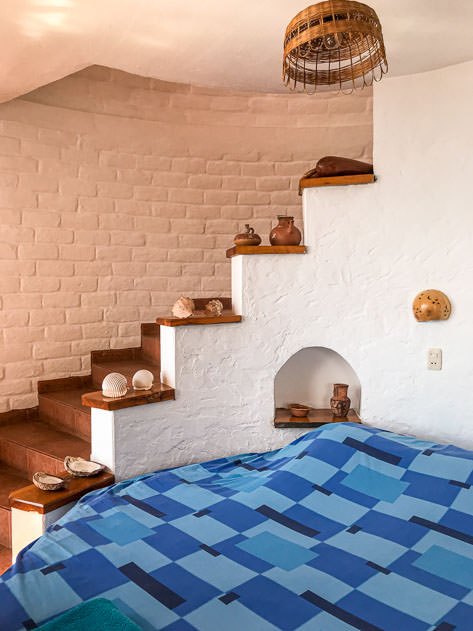
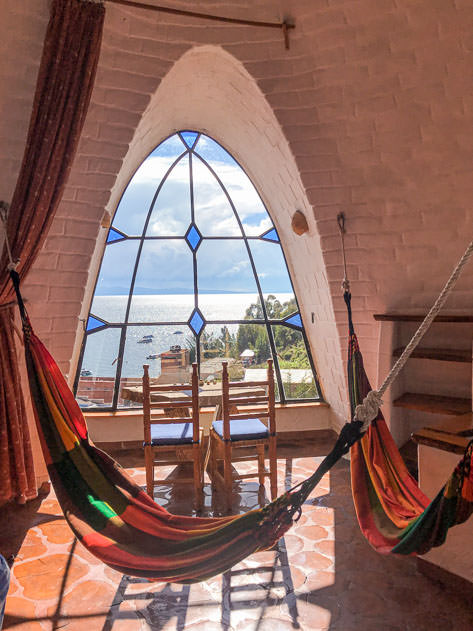
- The neighboring hotel La Cúpula, and especially its restaurant (see below) came highly recommended too.
- Ecolodge Copacabana: after returning from the Island of the Sun, we spent a night here since Hostal Las Olas (see above) wasn’t available. Located at the very end of the waterfront on avenida Costanera, we booked a cute adobe cabin. Unfortunately there was no wifi because of some technical problem and it was a bit cold, so we had to ask for a heater. However, the staff were helpful and they let us use the kitchen cafeteria to cook our own dinner. Breakfast was included and it had everything we could ask for: fresh juices, various fruits, sliced avocado, ham, cheese, bread, eggs and hot drinks.
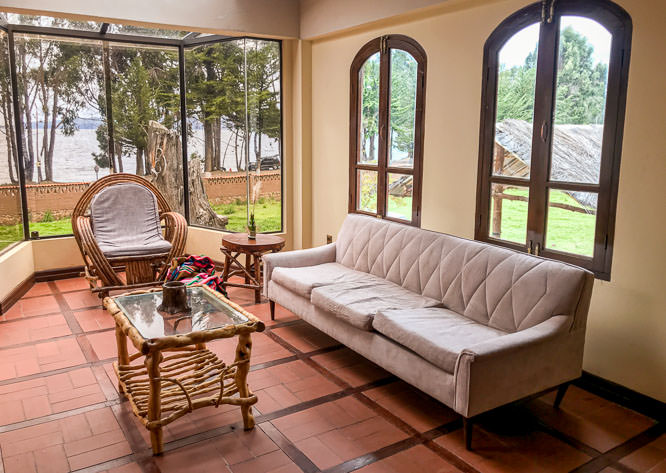
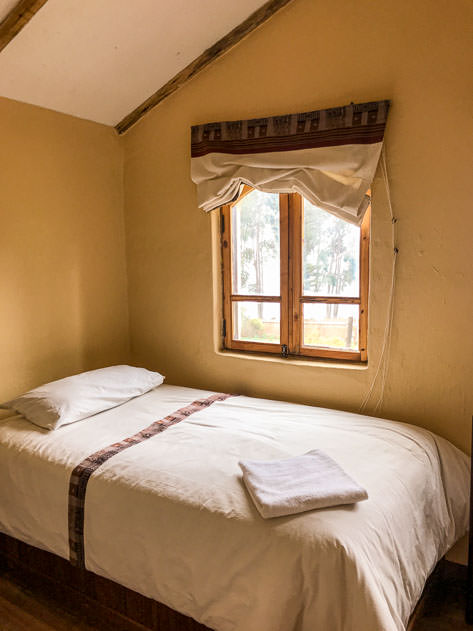
Where to eat in Copacabana
Since we had packed A LOT of food for our stay at the secluded cabin in Isla del Sol (see below), we didn’t venture much in terms of food-hunting. However, note that trout (‘trucha‘) is the most common food you’ll find in Copacabana because lake Titicaca is rich in fish. Most of the food stalls serving fresh trout are located along the lake shore in avenida Costanera. If you’re lucky, you might also find silverside fish (‘pejerrey‘).
The glorious night we stayed at Hostal Las Olas, we ordered three pizzas (ham –jamón-, margarita and vegetarian) from Trattoria Sapori d’Italia. Their two-people staff were so nice they even brought us the pizzas to the hot tub since the hostel was just a few steps away from their cute restaurant! I mean, what else could you ask for?
Another place that was recommended to us was La Cúpula restaurant, located within the premises of the hotel of the same name. Unfortunately, it was closed due to the pandemic so we didn’t get to try their famous fondue (I wish I could travel back to Switzerland right now!), nor their superlative trout and tempting desserts such as the chocolate ‘boliviana‘. Hopefully next time!
Finally, a truly original foodie experience to eat the famous trucha from lake Titicaca is to book a round trip with a boatman at the Copacabana harbor. They will take you to the Islas Flotantes (such as the ones in Chañi), which consist of various rafts by trout cages where they’ll fish out a trout for you and cook it straight away. Note that those rafts are made of ‘totora‘, a plant that grows in the area that is used for the construction of traditional rafts and boats.
Isla del Sol
How to get to Isla del Sol
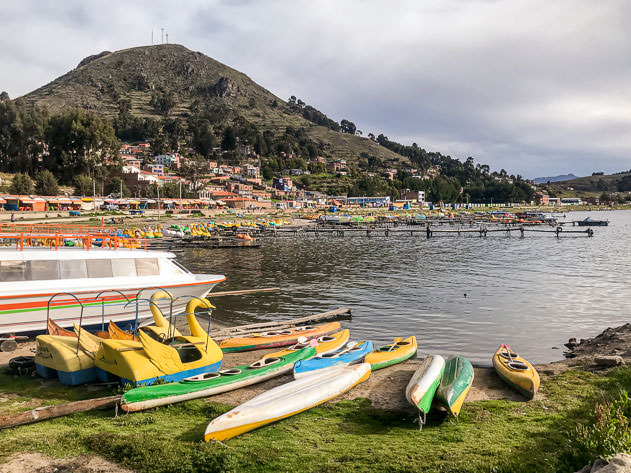
Since Isla del Sol is, well, an island, there’s no other way around it than getting here by boat.
Most boats depart from the waterfront located on avenida Costanera in Copacabana. A cheaper option though is to hike or take a taxi to Yampupata, located 17kms away. Depending on your final destination on Isla del Sol (namely Yumani in the south, Challa in the middle or Challapampa in the far north), the boat ride from Copacabana can take up to two hours.
Here are some tips for your boat ride to Isla del Sol:
- Allow sufficient time for the round trip because your boat might be late (as it was our case; we were supposed to leave Copacabana at noon and finally departed at 1.30pm, arriving to Challapampa around 3.30pm). Also, check the times well in advance to avoid unpleasant surprises such as not having a boat to go back to Copacabana after 4pm.
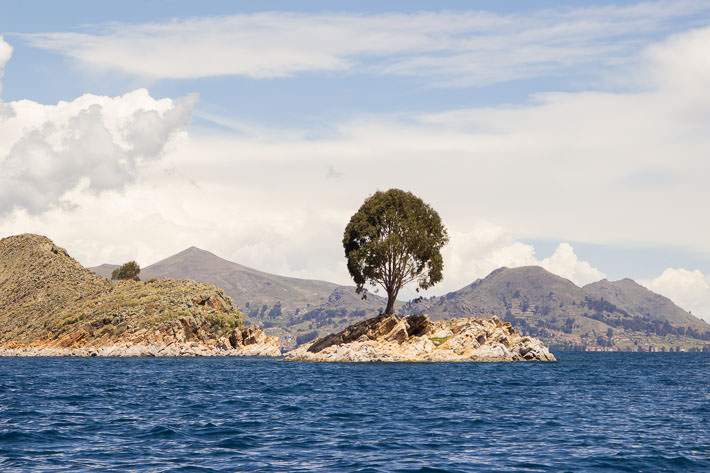
- The boat trip to the Isla del Sol might cost you anywhere from 25 Bs/ person (around 3.5USD) for the communal boat from Copacabana to Challapampa to 50 Bs/person (around 7USD), which is what we paid for our private boat from Yumani to Yampupata (it accommodated six of us). Of course, you can always shop around but this is to give you an idea! See the ‘trip cost’ section below to find all the details.
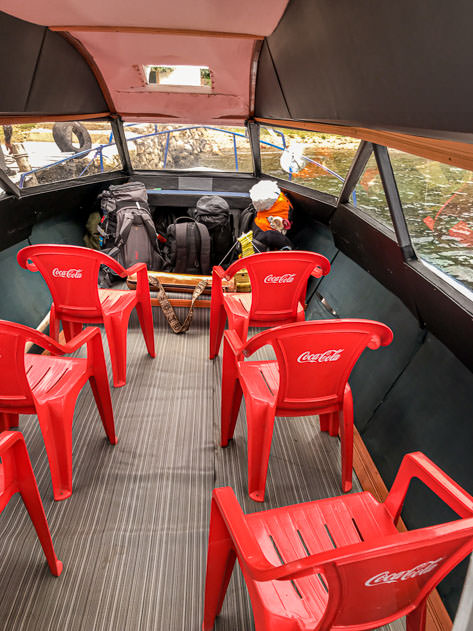
- Another thing you might want to consider, especially now in the middle of the COVID-19 pandemic, is that the boats can be quite crowded. For that reason, we sat outside to breathe some fresh air (and we actually met another Spanish expat who was crucial during our stay on the island as you will read below). A good alternative is to hire a private boat, which is what we did on our way back from Isla del Sol to Yampupata. This is a great choice if you’re a big enough group (we were six people). Besides, the trip is likely to be shorter since you can agree the itinerary beforehand and you don’t have to do as many stops as the regular boats.
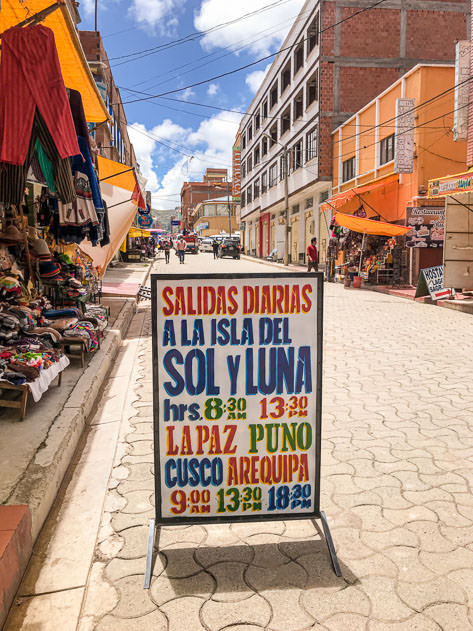
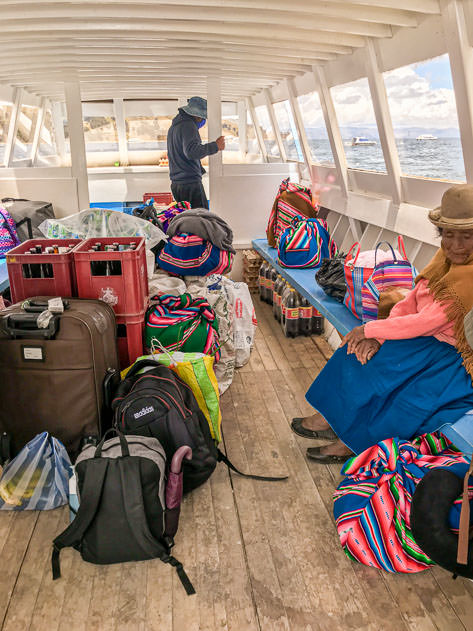
- Furthermore, don’t forget your sunscreen, your sunglasses and a hat to protect yourself from the harsh Andean sun. Remember you’re at almost 4,000 meters above sea level here and the sun is much more dangerous!
- There are two types of boats going to the Isla del Sol: they can either be communal or private. On our way to Isla del Sol, we had no problem when boarding the communal boat to Challapampa because we were with our Airbnb host. However, the day before we asked about the departure hours at the harbor and they told us we couldn’t travel unless we were ‘comunarios‘ (residents) from the island, so make sure you check that beforehand!
- Once you actually reach your destination on Isla del Sol, note that there are no actual roads nor vehicles on the island, so the only way to go around is by foot or by boat. By the way, you might hear that it’s not safe to travel to the northern part of Challapampa because a Korean girl was murdered some years ago, which has created a conflict with the southern community of Yumani. My take on this is that, as everywhere else, you should be careful and not talk to strangers. In any case, we hiked between Challapampa and Yumani and encountered no problems at all.
- Finally, you might find yourself disconnected from the outside world when visiting Isla del Sol. And I don’t mean this just figuratively but also quite literally. During our entire stay, I had no coverage at all. I have a Bolivian SIM card with TIGO and I heard ENTEL is better for this matter, so you might want to check that out prior to departure.
What to do in Isla del Sol
Isla del Sol (also know as the Island of the Sun) is, above all, a sacred place for the Aymara culture and their people. Hence, there are various spiritual landmarks throughout the island that you shouldn’t miss. In addition to that, the natural beauty of this place is worth mentioning and hiking between the northern and southern tips of Isla del Sol is definitely a bucket list activity. The three main settlements (Challapampa, Challa and Yumani) are all on the east coast and house several thousand Aymara campesinos (peasants).
Challapampa
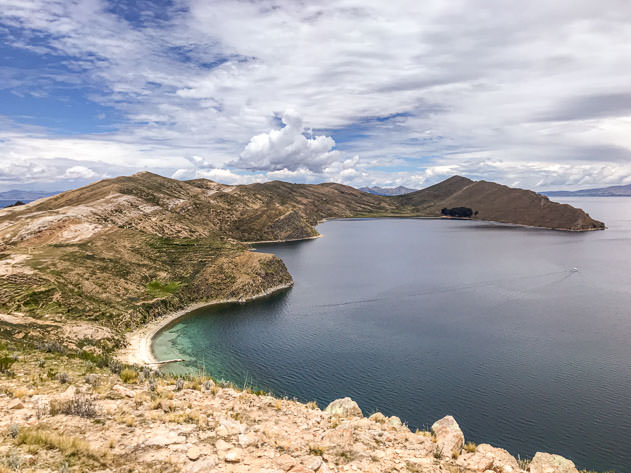
Also known as Cha’llapampa, this little community on the northern tip of the Island of the Sun features the most spectacular ruins (although to be honest, I was more impressed by the stunning landscapes than by the ancient temples). Taking the path around the beach with squealing pigs, you will go up on a steep road that passes through a simple school and houses. You will see an idyllic beach called Playa de la Sirena surrounded by fields of quinoa and broad beans. Around 40 minutes later, you should have reached an area called Kasapata. It is believed this was an Inca village or a waystation for pilgrims back in the day. The travel guides I had read indicated there was a checkpoint here where we should show our ticket purchased at the Museo del Oro in Challapampa. However, as it is often the case in Bolivia, the space was unattended (maybe because of COVID and the lack of tourists?).
Following the path near Kasapata, you will find a carved stone block (Piedra Sagrada) as well as the Titikala (Roca Sagrada), a huge slab of sandstone on the right. If you keep going, you will see the Labyrinth (also known as Chincana or Palacio del Inca). This ruined complex was interesting because of the interlinked rooms and passageways and the gorgeous views over a deserted beach right under (we actually went for a dip here with some friends afterwards and loved it although the clear water was freezing!).
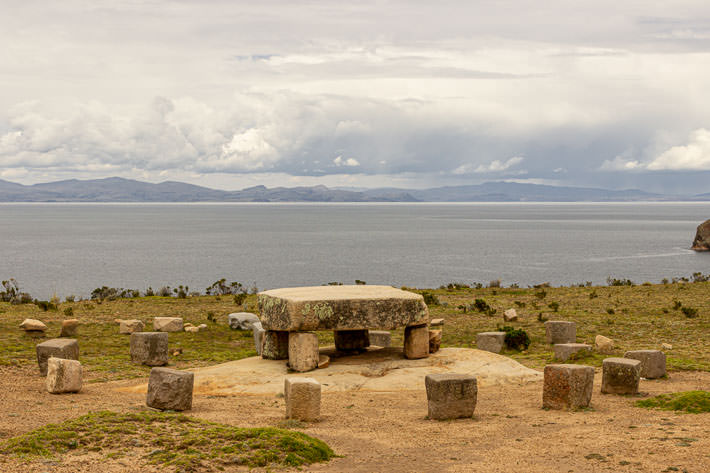
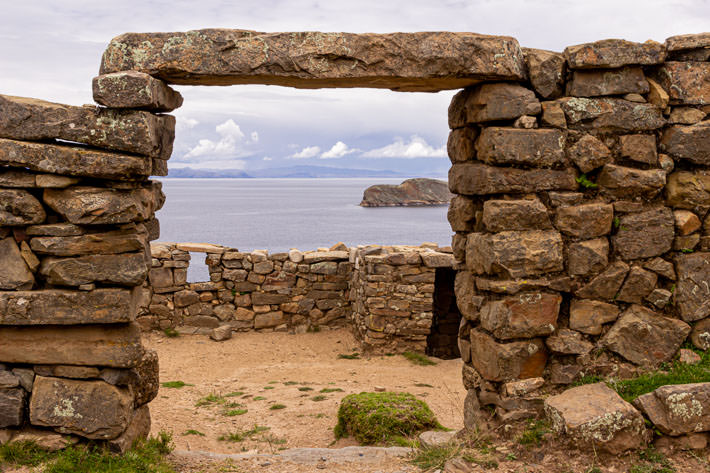
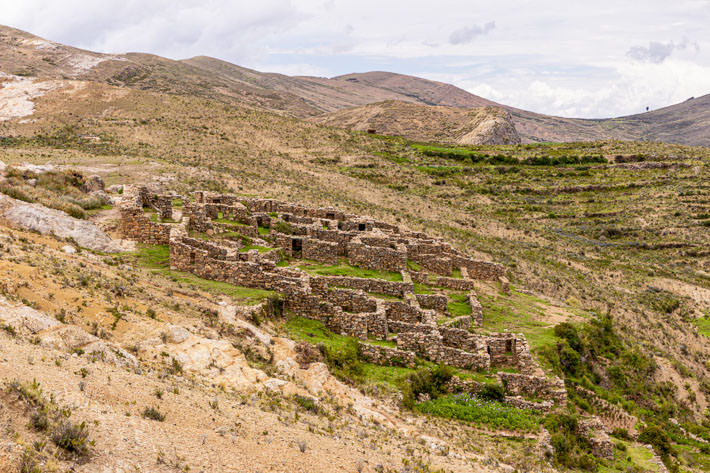
If you still have the energy, keep walking up for another fifteen minutes all the way to Cerro Tikani, located at almost 4,000 meters above sea level. On a clear day, you might see the imperious snowed peaks of the Cordillera Real rising above the shore on the mainland to the east.
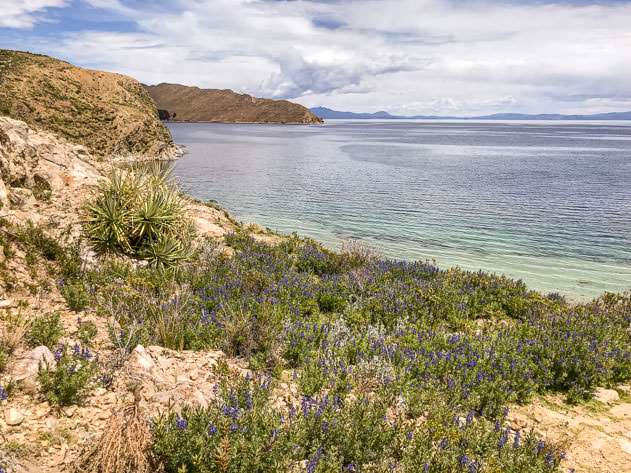

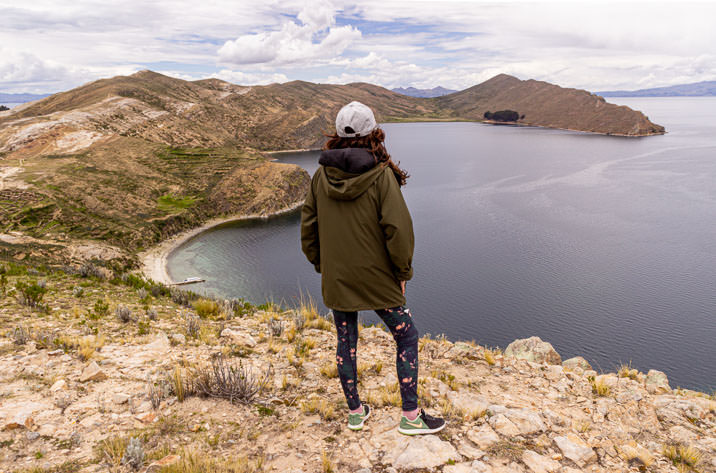
On our way back, instead of taking the left path from where we came in the morning, we took the right hand one, which connects with the Ruta Sagrada de la Eternidad all the way to Yumani. Although we stayed in the area of Challapampa, we ended up on a very steep rocky hill right before sunset and we were unsure how to return to the civilized world. Thankfully, we found a local farmer who helped us find a way and we finished meeting her family as well as her pigs.


Challa
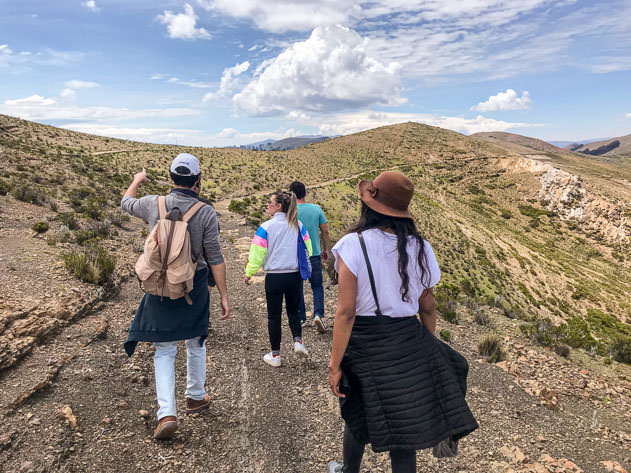
On Sunday, we left Challapampa quite early to hike along the Ruta Sagrada de la Eternidad all the way to Yumani. Allow around four hours for this 7km trail that will take you through the central ridge of the island and be careful with the altitude sickness. About an hour after leaving Challapampa, we saw the beach of Cha’lla (Playa Challa) from the path (there was even hail where we were). It seems that other than enjoying at the beach, there’s not much more to do in this village.
The road goes up and down until you reach the southern community of Yumani.
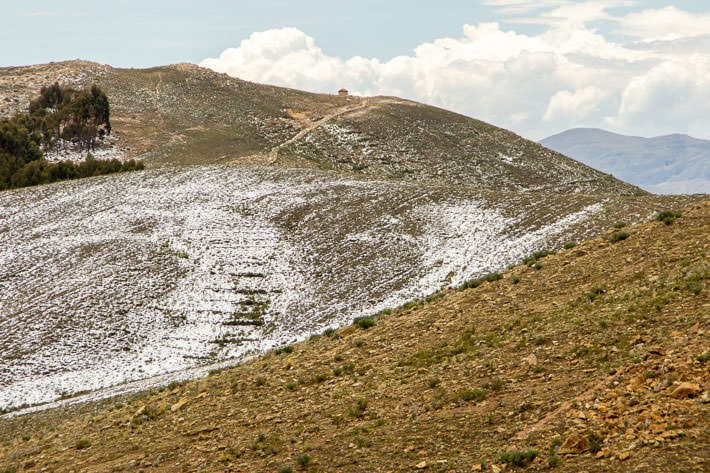
Yumani
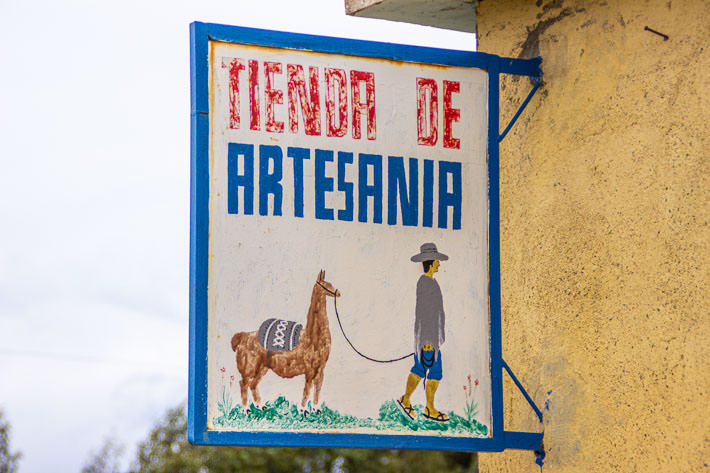
Yumani is the closest town to Yampupata and Copacabana and also the most touristy one. The attractions here include the steep 222 Inca stairs (Escalera del Inca) leading to a three-spouted spring (Fuente del Inca) and Pilko Kaina (also known as Templo del Sol or Temple of the Sun), an Inca site built on a cliff about 20 meters above lake Titicaca.
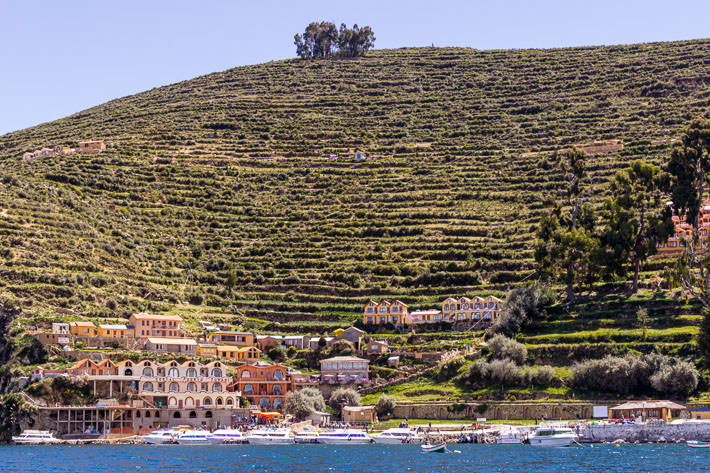
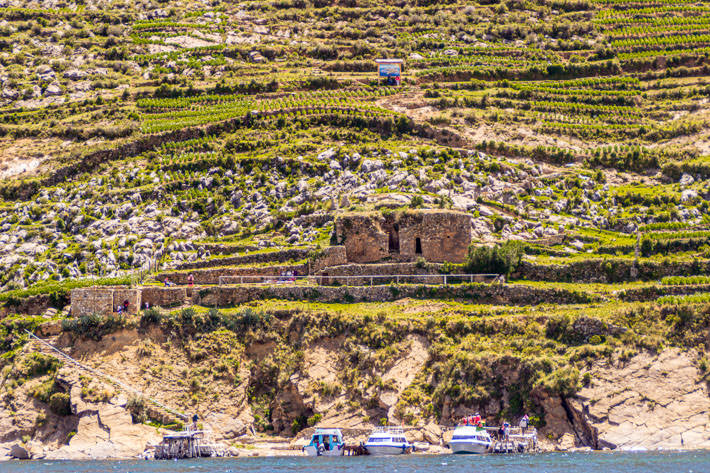
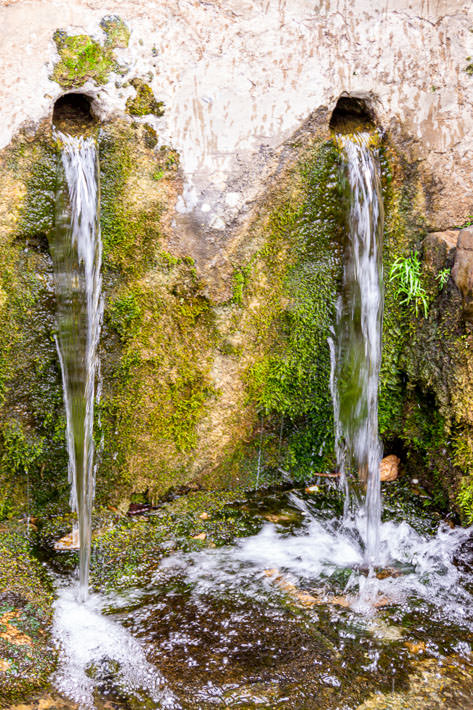

Where to stay in Isla del Sol
Most of the accommodation options on Isla del Sol are located in Yumani, on the southern tip of the island. But to be honest I’m glad we didn’t stay here because of where it’s located: on a VERY steep hill. As you can imagine, this is rather inconvenient, especially if you’re arriving with a big backpack. There are actually donkeys down at the Yumani harbor to bring up the various travelers’ belongings, which reminded me of the Greek island of Santorini! Furthermore, given the COVID pandemic, we preferred to stay away from big crowds, which is why we had planned the perfect weekend getaway in a secluded cabin by Playa de la Sirena in Challapampa. Unfortunately, it turned out WRONG.
Initially, we had booked this small cabin. But since we were going to spend three nights in the northern tip of the island, we preferred to book the bigger cabin next door. We contacted our host and arranged the logistics with her, including the boat to get us to the island. She had warned us that the cabin had no wifi nor hot water and that it was a bit distant from the village, which is why we brought plenty of food for our stay. However, when we finally arrived to Challapampa with her and her daughter, the road was SO steep and we were sick and tired of carrying our very heavy bags under the sun. Eventually, we reached the cabin by the beach but she had forgotten the keys, so she had to find a way to break the lock on the door. When we finally stepped in, we realized our ideal accommodation wasn’t what we were expecting at all: there were food and dishes on the floor, the main room was filled with big bags and the cabin was messy and dirty. Unfortunately, we had to leave without even unpacking and look for a last-minute accommodation in the village. Luckily, we found our Spanish friend from the boat at Hostal Challapampa and that’s where we stayed for the next two nights.

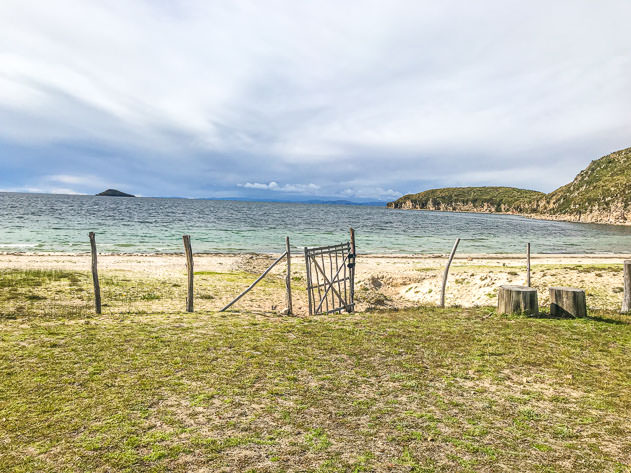
This simple hostel located at the end of the waterfront is owned by Víctor and his family. After our bad experience with the ideal beach cabin, this was all we could possibly ask for. We had a spacious room, a shower with hot water and they even let us use their tiny kitchen to cook our own food. Besides, Víctor was really helpful and he arranged a private boat for us and our friends to get back from Yumani to Yampupata and he also took our luggage so we didn’t have to carry it during the four-hour hike from Challapampa to Yumani along the Ruta Sagrada de la Eternidad.
By the way, I truly have to give kudos to the Airbnb team because they reimbursed me in full following my claim, even though I couldn’t make it in the next 48 hours since I had no coverage on the island.
Where to eat in Isla del Sol
Since we stayed a couple of nights in Challapampa, this is where my recommendations are based. However, don’t expect too much as the food here was very simple and I believe we tried the two only restaurants in town. 🙂 Both restaurants were located on the waterfront, close to the dock. The first night we spent on the island we had dinner with other Spaniards consisting of quinoa soup, chicken with rice, chips and vegetables. It was actually nice to eat warm food because at night the weather turned out to be very windy, rainy and cold. The nearby hostel where we were sleeping (Hostal Challapampa) offered a decent breakfast at their restaurant on the waterfront, including fresh orange juice, slices of banana and papaya, coffee or tea, bread with butter and strawberry jam as well as eggs (scrambled or fried).
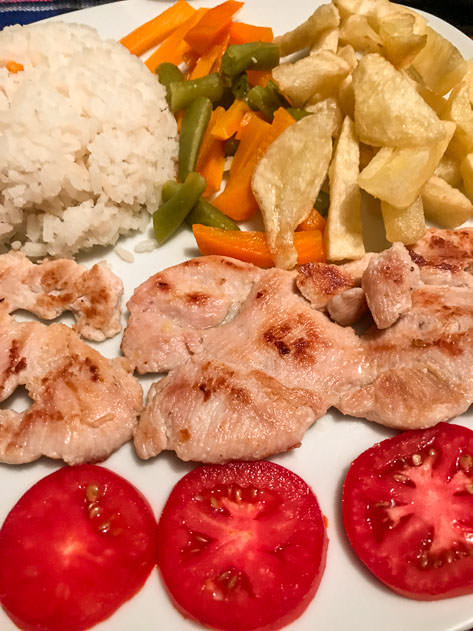
The food story in Yumani was quite different since it’s the most touristy spot on the island. But from what we saw during our itinerary, most restaurants offered pizzas, pasta or trout, which wasn’t very attractive.
Isla de la Luna
The Island of the Moon (Isla de la Luna) is a short boat ride from both Yumani or Yampupata. Although much smaller than the neighboring Isla del Sol, this island was also an important Inca religious site. The main landmark here is a temple known as Iñak Uyu.
The Court of Women was probably a temple dedicated to the moon and staffed entirely by women.
Although we had planned this to be our last stop on our way back to Yampupata, we couldn’t make it to the Isla de la Luna because of the bad weather and high waves on the lake.
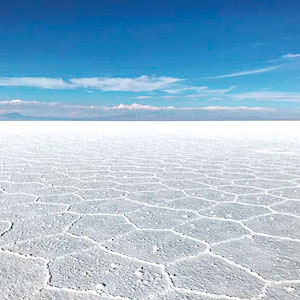
Bolivia
Check out practical information about the country + related blog posts!
Trip cost
Below you’ll find the breakdown of costs for our entire trip, including the visit to the ruins of Tiwanaku. The prices are shown in Bolivianos (Bs) as well as in dollars (USD).
- Taxi to the Tarija airport: 20Bs (2,89 USD)
- Fee for flying from Tarija to La Paz: 11 Bs (1,59 USD)
- Private taxi from El Alto to Copacabana, including tolls and the boat in Estrecho de Tiquina: 840 Bs (121,74 USD)
- Pizzas at Trattoria Sapori d’Italia: 105 Bs (15,21 USD)
- Accommodation in Hostal Las Olas, including four beers and the hot tub for two: 490 Bs (71,02 USD)
- Grocery shopping in Copacabana: 14Bs (2,02 USD)
- Communal boat from Copacabana to Challapampa: 25 Bs/person, so 50 Bs (7,24 USD)
- Grocery shopping in Challapampa: 12 Bs (1,73 USD)
- Accommodation in Challapampa Hostel in Isla del Sol: 373 Bs (54,05 USD)
- Dinner in Challapampa: 54 Bs (7,82 USD)
- Private boat from Yumani to Yampupata: 50 Bs/person, so 100 Bs (14,49 USD) (TIP: if possible, try to find other backpackers who might want to join you on the boat so you split the cost and you enjoy greater flexibility in terms of time. Besides, the boat owner might take your luggage on the boat so you don’t want have to carry it all the way from Challapampa to Yumani as was our case).
- Taxi from Yampupata to our hostel in Copacabana: 50 Bs (7,24 USD)
- Accommodation in Ecolodge Copacabana: 450 Bs (65,22 USD)
- Private taxi from Copacabana to Tiwanaku and then to La Paz: 1260 Bs (182,57 USD)
- Entrance fee to Tiwanaku: 15 Bs/person, so 30 Bs (4,34 USD)
- Taxi after dinner in La Paz: 18 Bs (2,60 USD)
- Taxi to the airport La Paz/El Alto: 80 Bs (11,59 USD)
- Taxi from the Tarija airport home: 20Bs (2,89 USD)
- TOTAL COST for two people: 3977,30 Bs (576,25 USD)
NOTE: I didn’t add our flight to and from Tarija to La Paz because we used tickets that got canceled last year due to the COVID pandemic. In La Paz, we slept at a friends’ house, which is why there is no accommodation cost in town.
Trip details
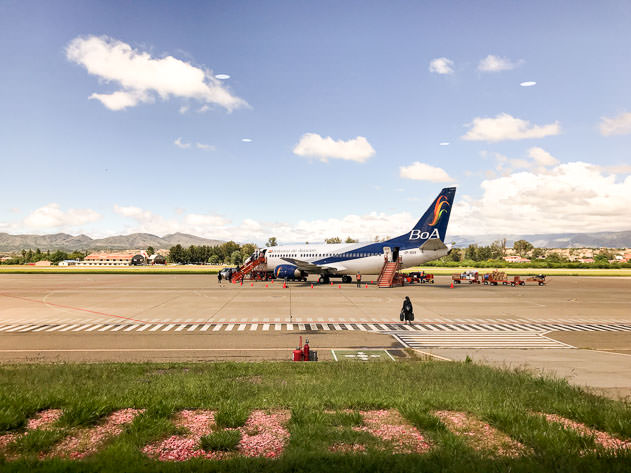
In case you were wondering how we got from point A to point B, here’s all the information so you can plan accordingly too. If you’re more of a visual person, which I am, you can also refer to the map below to put things into perspective!
- From Tarija to La Paz (round trip) : we flew with the Bolivian airline BOA to the international airport of La Paz in El Alto. The trip takes around an hour. If it’s your first time traveling to such a high place, pack some Sorojchi pills and drink plenty of water to prevent altitude sickness. It’s better to be safe than sorry!
- From La Paz to Copacabana (and back): we hired a private taxi with our old friend don Óscar. He used to drive my boyfriend when he traveled to La Paz for work. But since the COVID-19 pandemic hit, his activity has been on the low, so we wanted to support his business. Besides, we like the way he drives as he’s very cautious, which is not very common on the Bolivian roads these days. 🙂 On our way from Copacabana, we went to El Alto and from there to Tiwanaku and back to La Paz to sleep at our friends’ house.
- From Copacabana to Isla del Sol: we bought a ticket for a communal boat with our failed Airbnb host.
- Isla del Sol: there are no vehicles here, so the only way to get around is by foot or by boat.
- From Yumani on Isla del Sol to Yampupata: we took a taxi to our hotel in Copacabana.
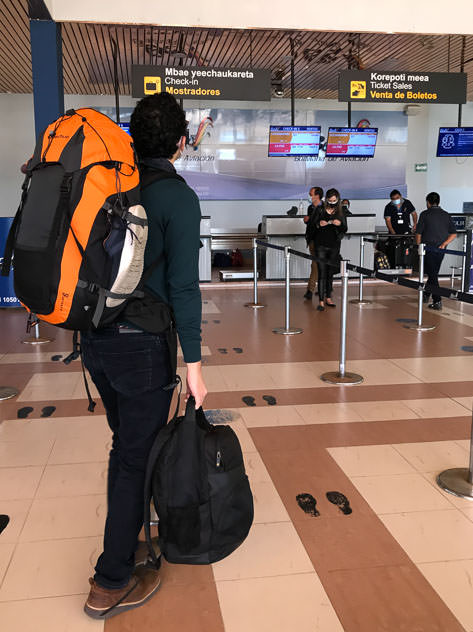
Map of lake Titicaca & around
Below you will find a map with all the spots mentioned throughout this blog post. Use it to plan your next trip!
Since you’re here, you may want to leave a comment if you enjoyed this post and/or keep on reading about other destinations near the Titicaca lake on this blog:
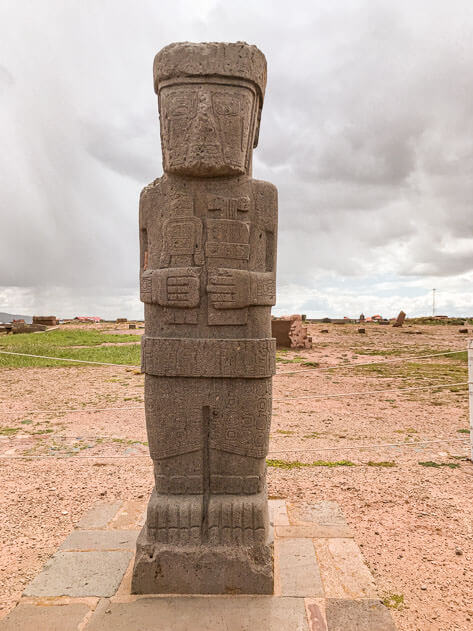
- La Paz
- El Alto

